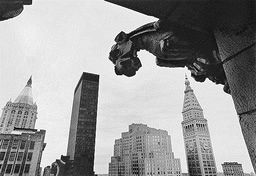
Harry Wilks, a photographer who works high above New York City's streets, doesn't look down, only across. And he's spent the last 23 years immortalizing Manhattan's rooftops, constructing an alternate world, an urban fantasy land of right angles, stone monsters and dramatic protrusions.
His pictures, he says, are a puzzle that I put together with different shapes and forms that make a different kind of sense from what the observable reality is. I want to show people things they can't see with their own eyes.' And so, in 40 Wall Street, from 1992, his lens takes in the twin pillars of the World Trade Center in the far distance, but what really absorbs his interest are the bulky battlements right in front of him, which loom much larger here than they do in real life. He isolates shapes not meant to be viewed from up close or from behind, and certainly never meant to tower so menacingly.
Wilks is one of the contemporary chroniclers of rooftop New York, the subject of a new exhibit at the New York Historical Society called "Up on the Roof: The Culture of New York City Rooftops."
Ariella Budick, New York Newsday
"Panorama photography usually concentrates on the big picture, squeezing in as much as possible. But Wilks enlists the format to give unexpected character to the quotidian. In one, the blunt end of a parking lot guardrail takes on seriocomic grandeur as a Metro-North train breezes past. In another, the crenelated facade of an old-time Wall Street skyscraper looks like a row of pawns about to challenge the bigger, newer buildings to a game of chess."
The New Yorker
"At O.K. Harris there is a show of photographs of New York by Harry Wilks. . . . He reverses the conventional view of Manhattan, which is that the skyline is the redeeming feature and the foregroundis by comparison rather drab. And he does it with zest, an eye for formal values and a fund of invention that banishes all thought of formula."
John Russell, The New York Times
"Wilks is an intrepid explorer of New York's rooftops. He hauls his camera up there not to look down, but to look out over other rooftops. His black and white photos are not so much pictures of buildings as pictures from buildings. It's a whole new landscape up there. Rooftops sprout temples, turrets and pavilions. Vents loom with the eerie monumentality of Stonehenge. Here is the other Statue of Liberty, the one on West 64th Street who lifts her lamp beside the Empire Hotel.
With no ground from which to measure, foreground and background lose their meaning. Stone vases, parapets, balustrades, arches, pediments, crowns, pipes, fans, skylights and other architectural bric-a-brac vie for attention with the towers rising in the background. A pair of ornamental metal balls on pedestals are as massive as the twin towers of the World Trade Center, and far more interesting.
Wilks' photographs are really a very concise form of architectural criticism. His photo Sixth Avenue Towers, five perfect steel and glass clones marching abreast, speak whole chapters about the sterile essence of the modern cityscape.
Bill Marvel, Dallas Times Herald
". . . In Manhattan Observed: 14 Photographers Look at New York, 1972-81, at the New-York Historical Society. . . . Mr. Wilks uses the vocabulary of architectural ornament as a way of ‘carving' out images that attain a remarkable sculptural power. . . "
Hilton Kramer, The New York Times
"Harry Wilks's photos of rooftop structures and vistas surprise, amuse and dislocate all at once. . . A thoroughly urban photographer, [he] rejects the distant view in favor of an unexpected cityscape closer at hand on various levels of the middle ground. . . [His Architectural] Ornaments series records an unsuspected architectural no-man's-land of empty rooftops and neglected decorative structures, purposefully conceived, carefully made and today rarely noticed. Wilks emphasizes both their elegance and pathos: sometimes by shooting them in surrealistic isolation against the discomfitingly regular facades of more modern buildings, sometimes by simply describing their solitariness.
. . . Wilks's pleasure in taking things out of context provides his work with refreshing glimpses of humor and fantasy. Over a low brick restraining wall on the roof of 299 Park Avenue loom the disembodied tops of the Waldorf-Astoria towers and the Citicorp building. The distance is foreshortened. The forms no longer seem objects in an urban landscape. . . . Exaggerating the scale of three ruthlessly geometric Sixth Avenue office buildings, Wilks turns them into tombstones. . . .
It is not surprising to discover that Wilks has been interested in architecture for a long time and that his understanding of its disciplines is more thorough than that of other photographers who share his delight in exploring its shapes and rhythms. Born and raised in Brooklyn, Wilks graduated in 1967 from City College where he studied first architecture and subsequently art and design. After graduation he worked as an architectural draftsman for five years before taking up photography as a serious occupation."
Carol Stevens, Print Magazine
